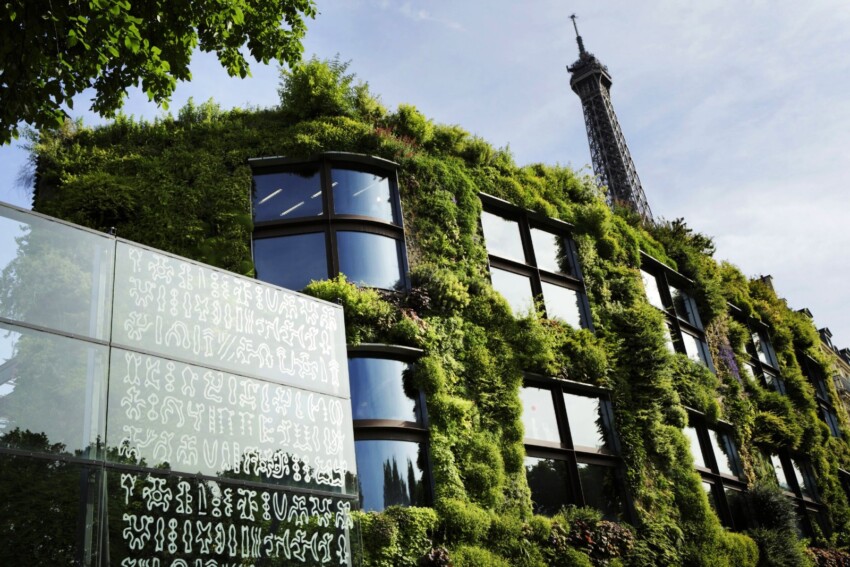
The Musée du quai Branly, a museum of the primitive arts and civilisations of Africa, Asia, Oceania and the Americas, located in the immediate vicinity of the Eiffel Tower, is undoubtedly one of Paris’s leading cultural institutions.
Immediately recognisable by its lush plant wall designed by botanist Patrick Blanc, it was opened in 2006 and focuses on non-European cultures. Featuring a theatre, a reading room, a cinema, 2 restaurants and a bookshop, the building designed by the famous architect Jean Nouvel is set in grounds reminiscent of a cultivated wilderness, and its 2-hectare garden is a pleasant place to relax after a visit.
The permanent collection and temporary exhibitions pay tribute to the richness of traditional arts and educate visitors about their significant contribution to world heritage. With an extraordinarily rich collection of 700,000 photographs and 300,000 artefacts and objects, including musical instruments, textiles, and clothing from Oceania, Asia, Africa and the Americas, the museum takes visitors on an eclectic and fascinating journey to discover the cultures of distant lands through the ages.
The temporary exhibitions offer a highly original perspective on the cultures that form their themes. They are contrasted with contemporary Western civilisation to make them more familiar and accessible, while retaining the mystical aspect that makes them endlessly fascinating.

The Musée du quai Branly is one of the 4 largest museums in Paris: it is composed of several buildings designed by architect Jean Nouvel with a total area of more than 40,000 square metres: the bridge-museum, the main building, is clad in wood and covered with glass facades, with a metal structure designed with reference to the nearby Eiffel Tower.
The University building houses the main entrance and a boutique bookshop decorated with Aboriginal paintings. The Branly building is used for museum administration. Finally, the canopy houses a media library and the museum’s reserves.
But the Quai Branly – Jacques Chirac Museum also has a magnificent garden, an oasis of peace and greenery in the heart of Paris, designed by landscape architect Gilles Clément.
The museum holds more than 1.3 million pieces: it is by far one of the richest places for non-Western artistic cultures in the world. It is organised by geographical area: African Arts, Asian Arts, Oceanian Arts and American Arts.
The central aisle of the museum is designed like a river and the visit will take you on a journey through masterpieces from all over the world, from antiquity to the modern age, through objects of all kinds: sculptures, paintings, casts, textiles, photographs, engravings, weapons, goldsmithing, drawings, posters, postcards, books, sound documents.
The permanent collection is regularly updated and upgraded, thanks to private donations, in particular that of French billionaire Marc Ladreit de Lacharrière, who donated 36 works from Africa and Oceania to the foundation.
Designed by Gilles Clément, the garden is an integral part of the museum: a bush garden covering 18,000 m². A unique space in Paris.
A place of nature and culture, the garden is an invitation to travel: paths, hillocks, paths paved with stream stones, ponds inviting meditation and daydreaming with 169 trees and some 30 plant species, oaks and maples on the north side, magnolias and cherry trees on the south side.
Thanks to its construction on stilts, the garden passes under the museum whose belly is planted with undergrowth grasses: it is outside that visitors to the museum find the ticket counters. In the heart of the garden, open-air performances, conferences and concerts are also held in an open-air theatre.
Guided by the work and reflections of Patrick Blanc, the green wall of the musée du quai Branly – Jacques Chirac was for a long time without equivalent. It remains today one of the largest in the world, both in terms of its surface area and the number of plants that make it up, a good 15,000.
The green wall, which covers one of the facades of the building on quai Branly, is part of the architectural framework designed by Jean Nouvel to house the museum’s collections. It has become an emblem of the museum: designed as a celebration of the African, Oceanic, American and Asian continents, the new wall will house 376 species from all over the world: imported from many mountain massifs such as the Moroccan Atlas, the Drakensberg of South Africa, the Himalayas, the mountains of Chile and Argentina, these plants can adapt to the climatic conditions of Western Europe.
A hymn to life, encounter and openness, the future green wall will carry the universalist message in the heart of Paris for several decades.
The museum is open Tuesday to Sunday, 10.30 am to 7 pm, except Thursdays, 10.30 am to 10 pm. The weekly closing time is Monday.
Please note that the museum has an exceptional closing time on 25 December and 1 May and an early closure on 24 and 31 December at 6 p.m.

Located at the foot of the Eiffel Tower, in the 7th arrondissement, the Musée du Quai Branly is easily accessible by many means of public transport.
You can reach it using metro line 9, Alma-Marceau stop or Iena stop, line 6, Bir Hakeim stop or line 8, Ecole Militaire stop.
Alternatively, you could opt for the RER C, Pont de l’Alma station or buses: Bosquet-Rapp stop (lines 42, 63, 80 and 92), Musée d’art Moderne – Palais de Tokyo stop (line 72), Champ-de-Mars stop (lines 82 and 69).
City Card allow you to save on public transport and / or on the entrances to the main tourist attractions.
